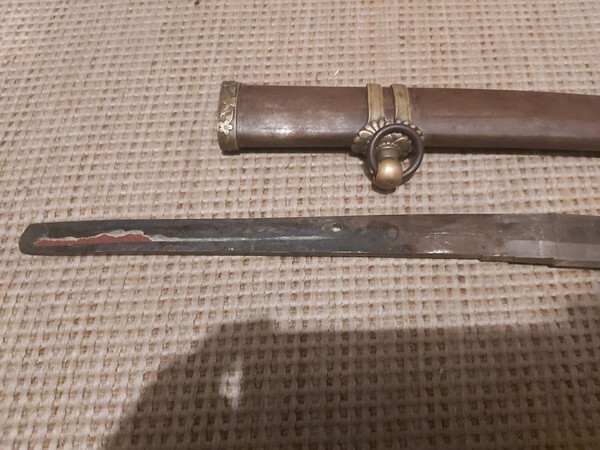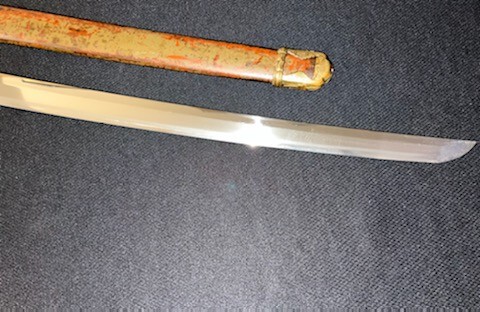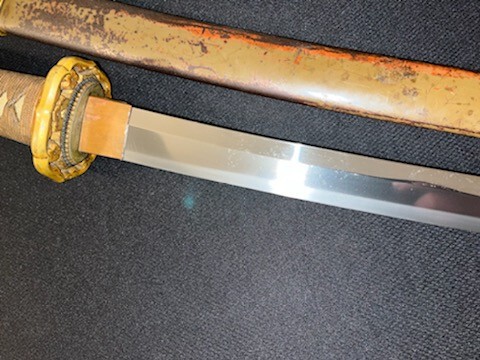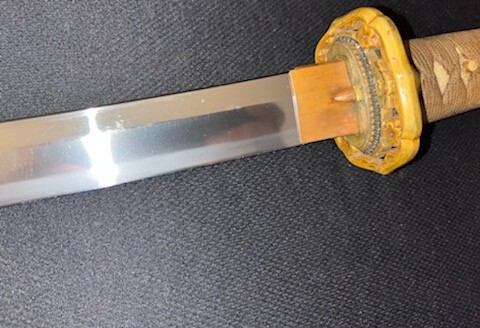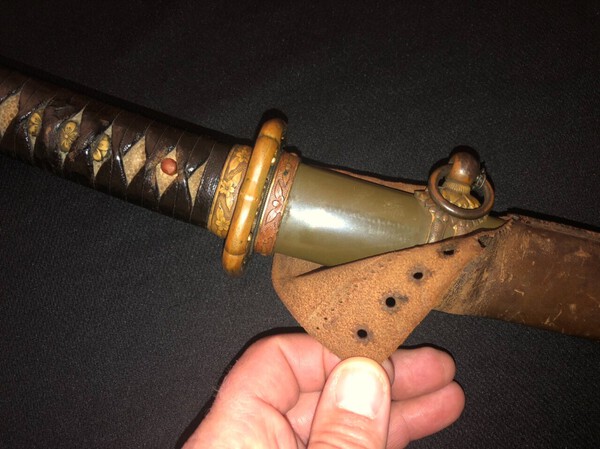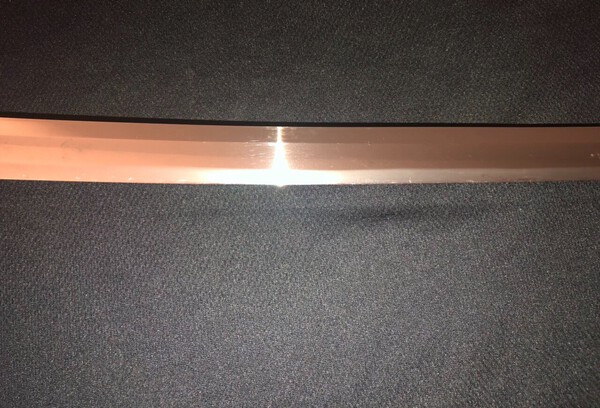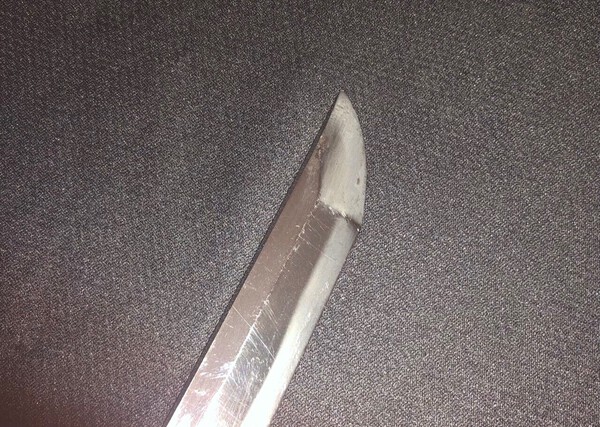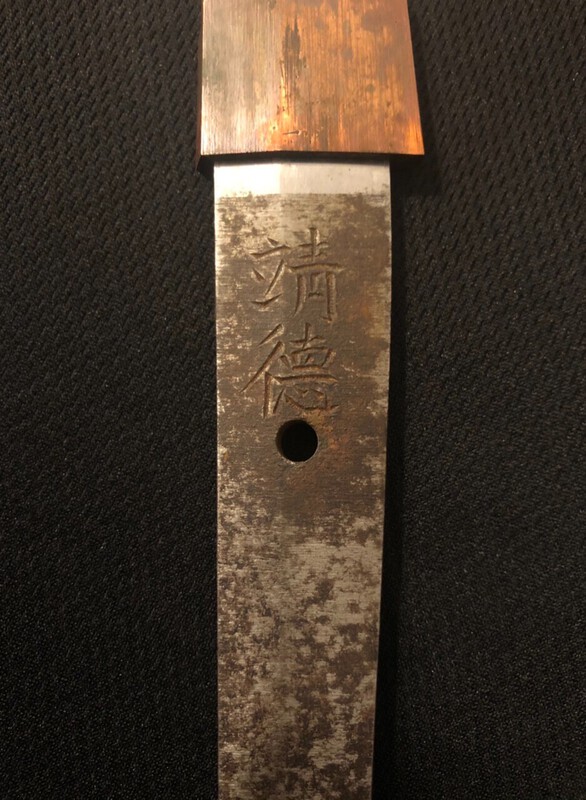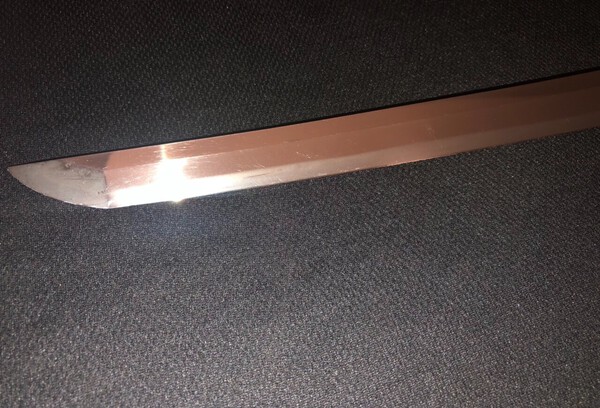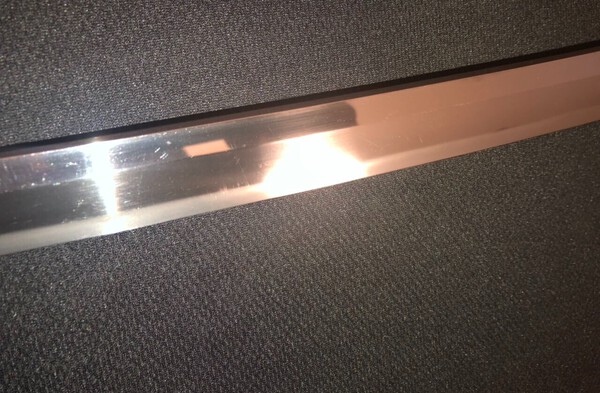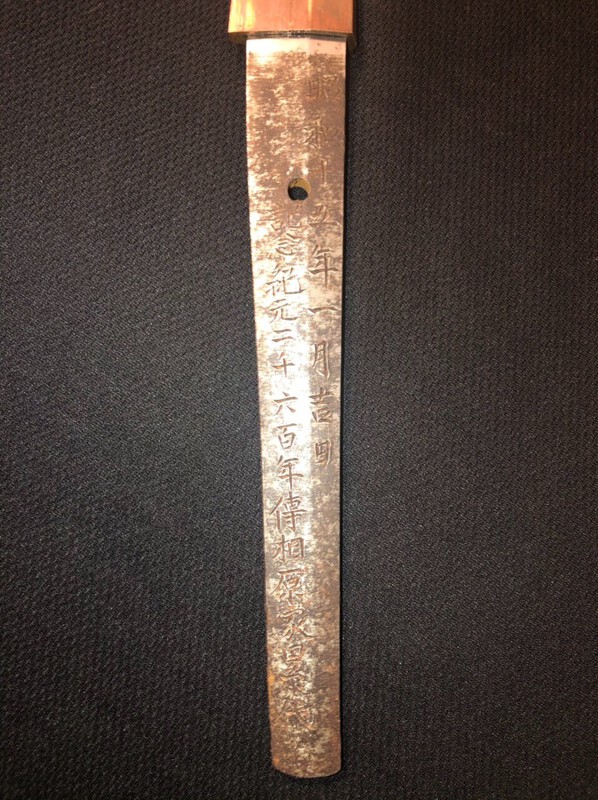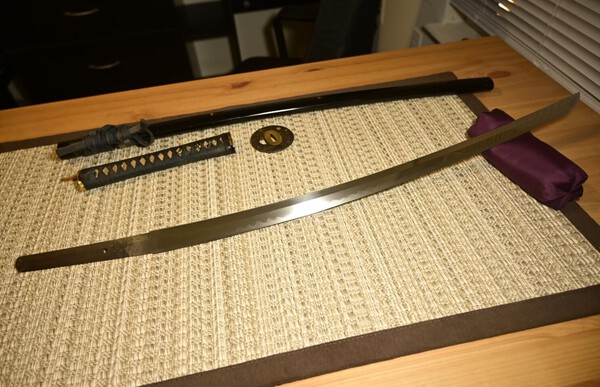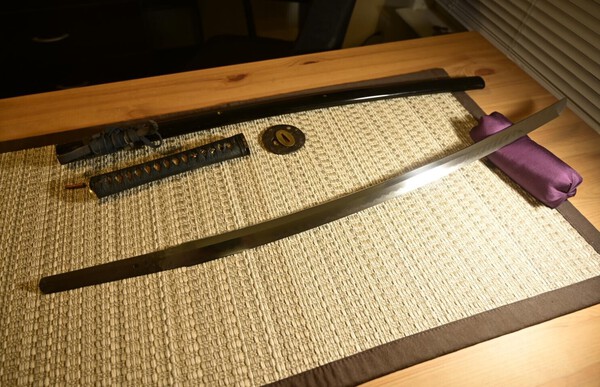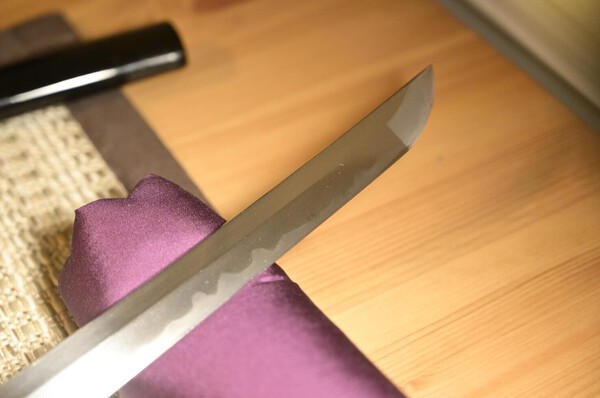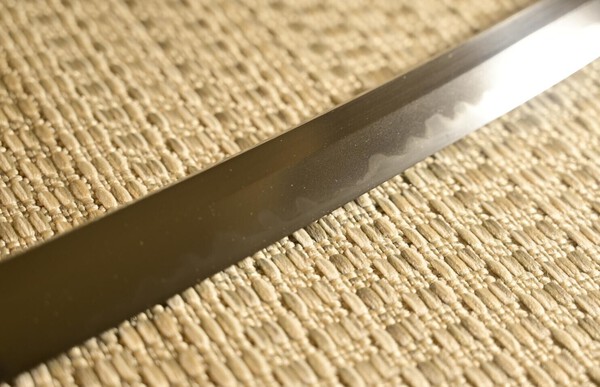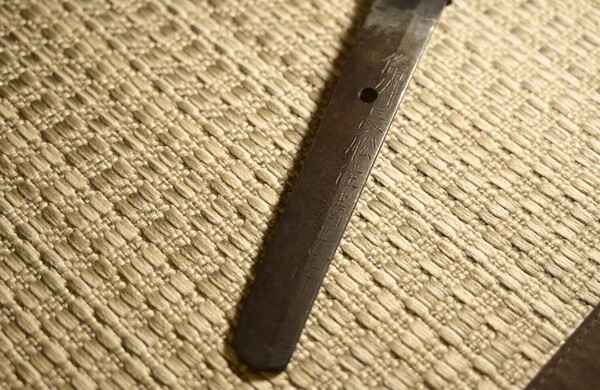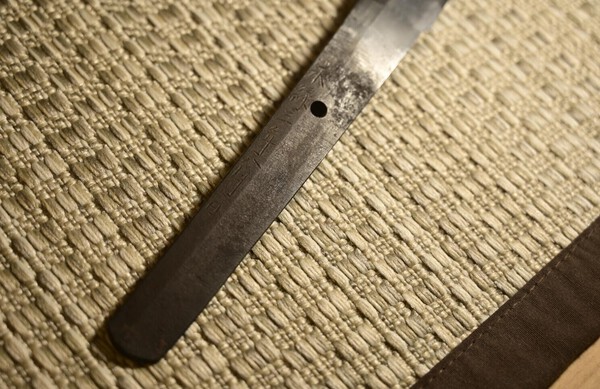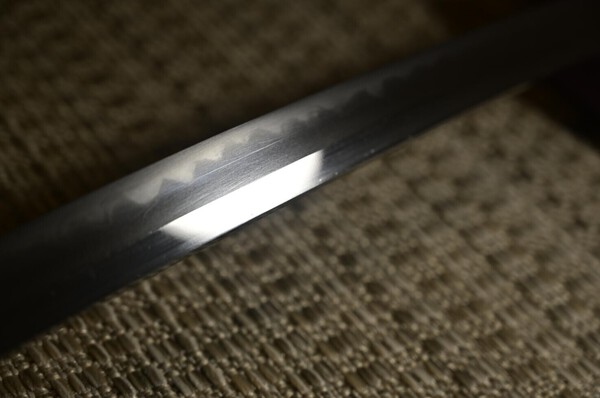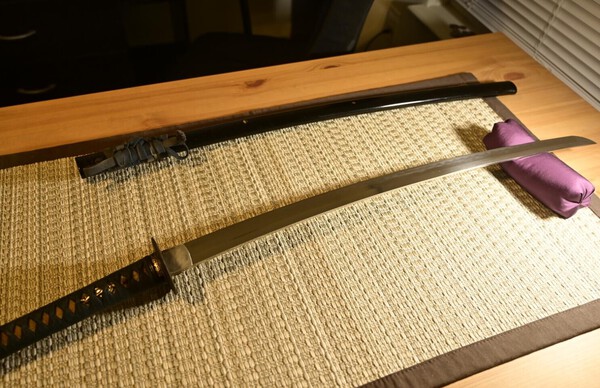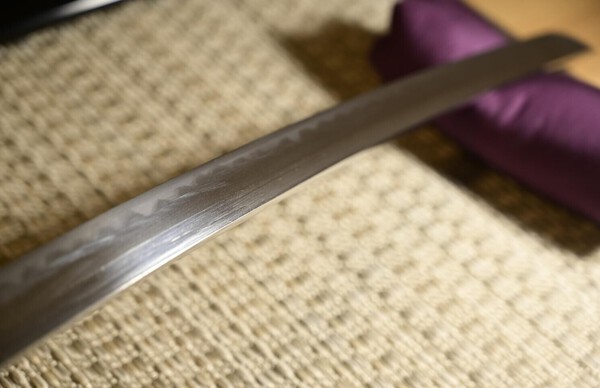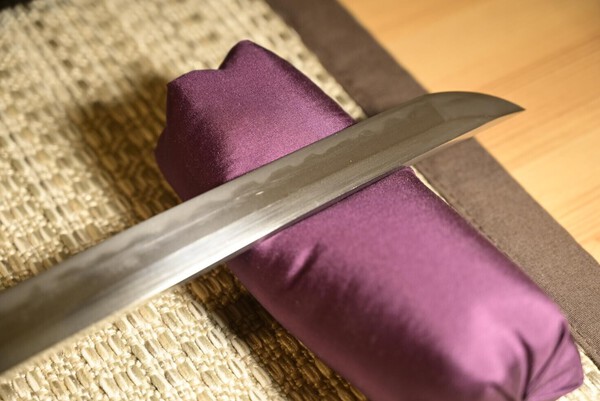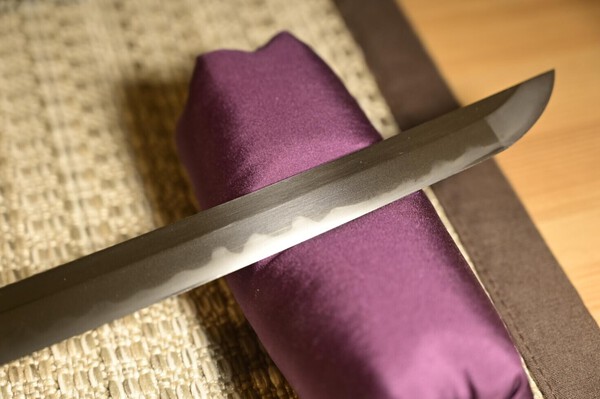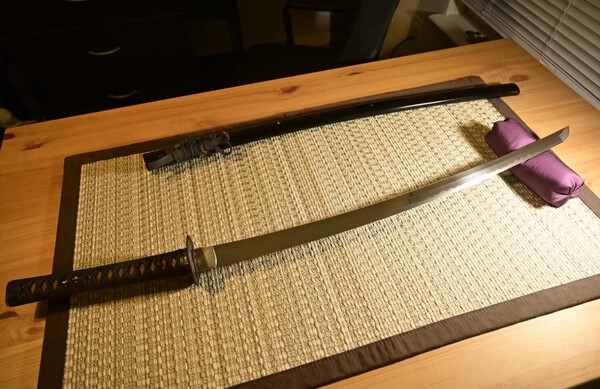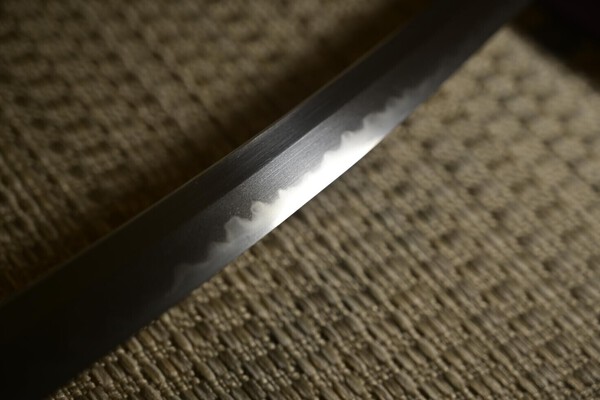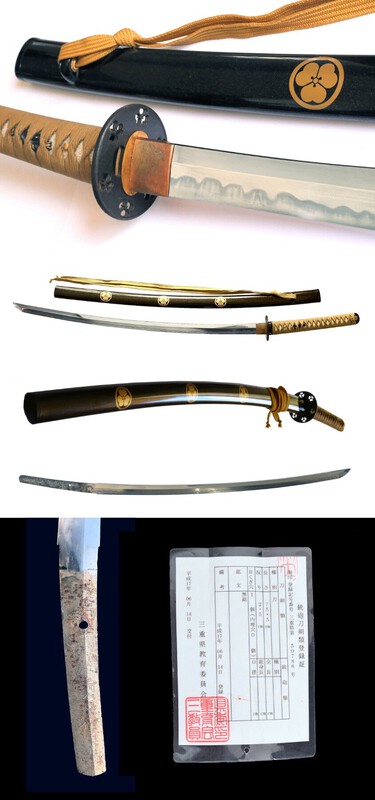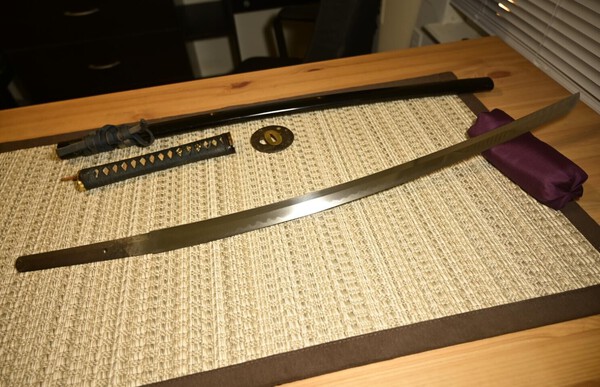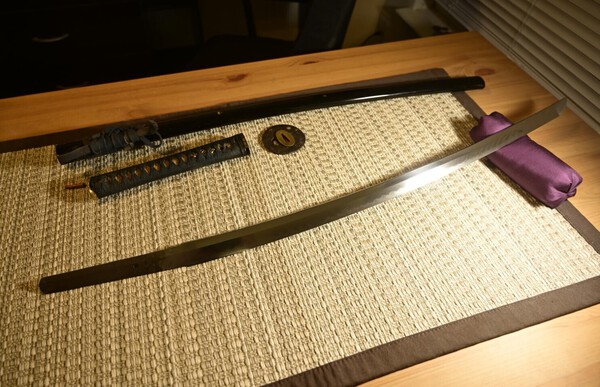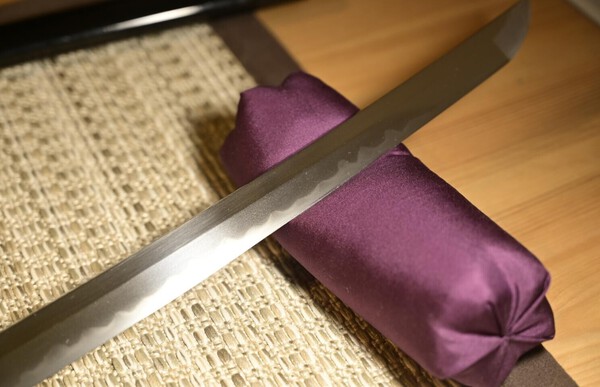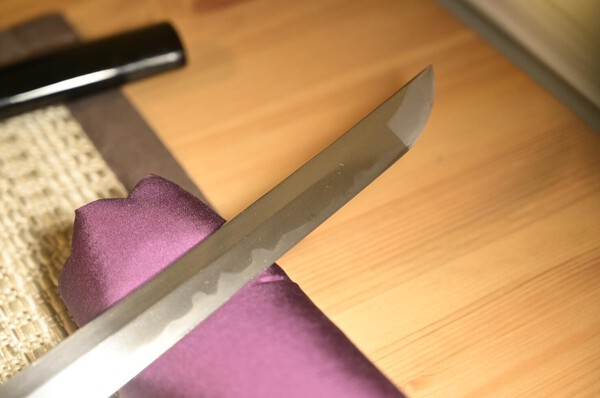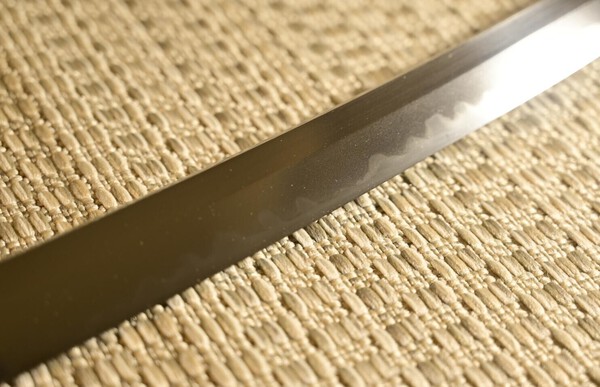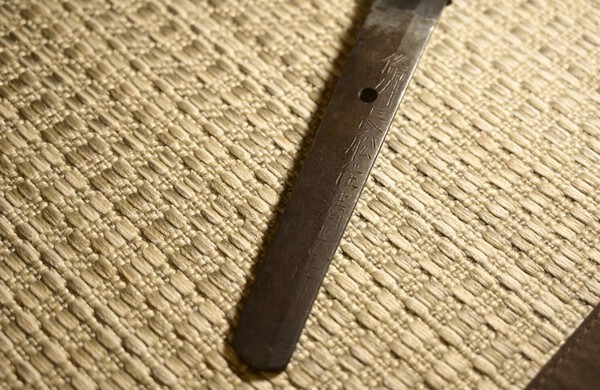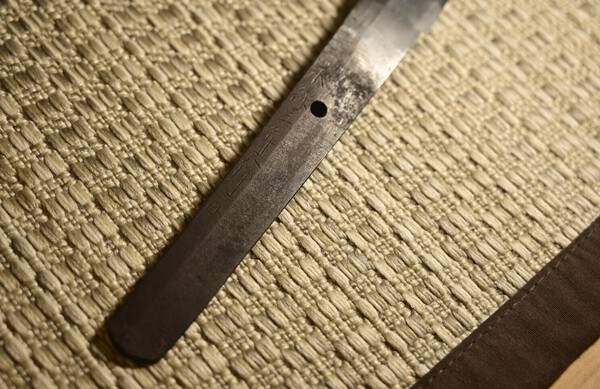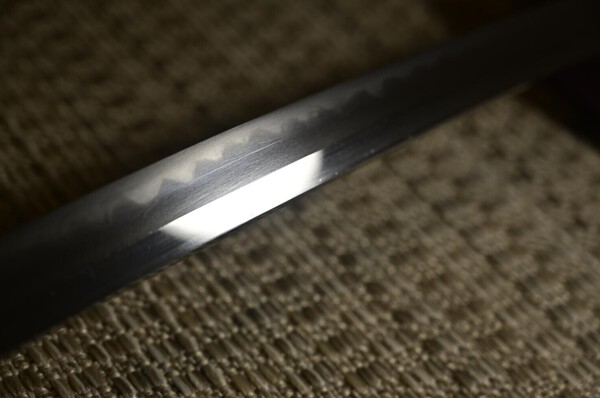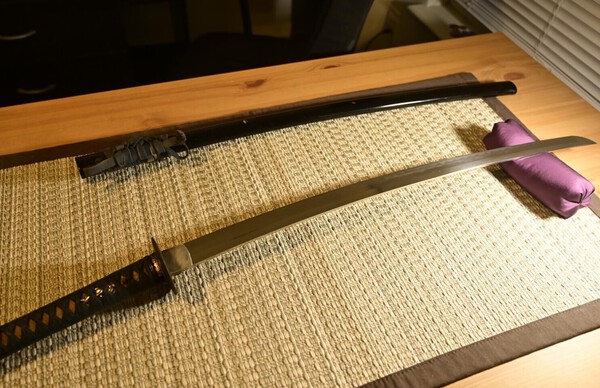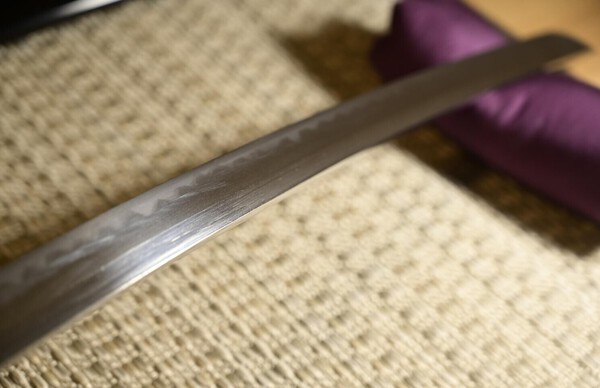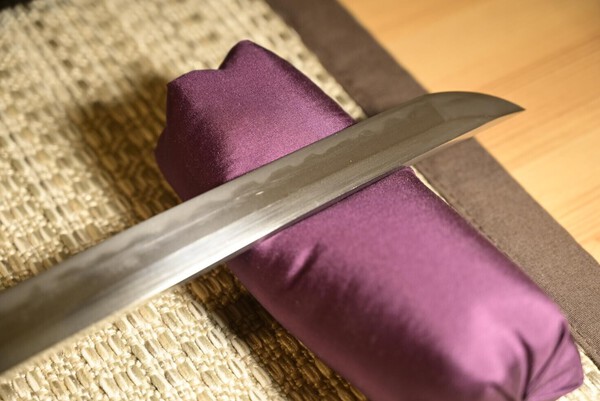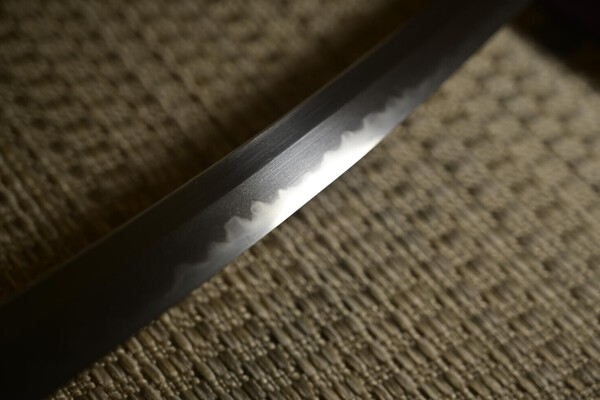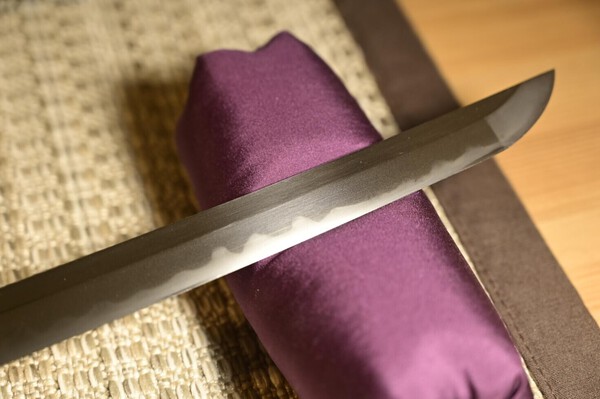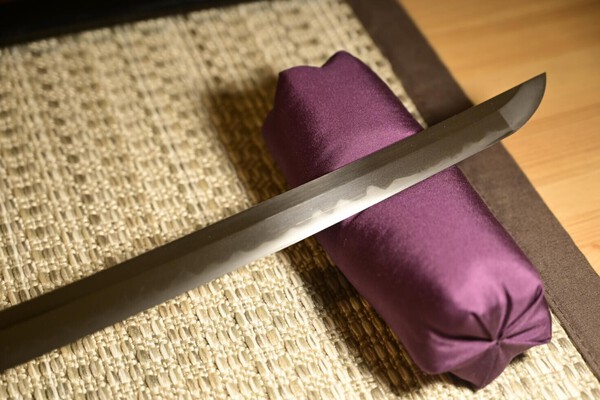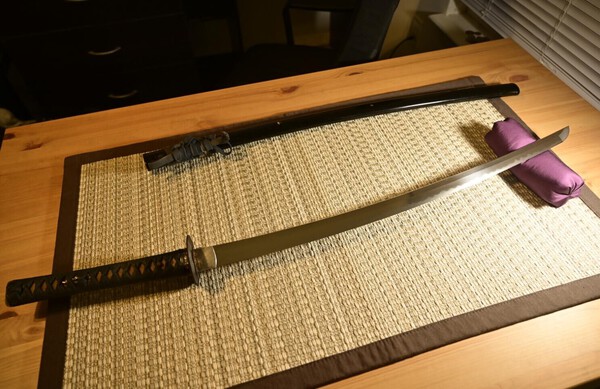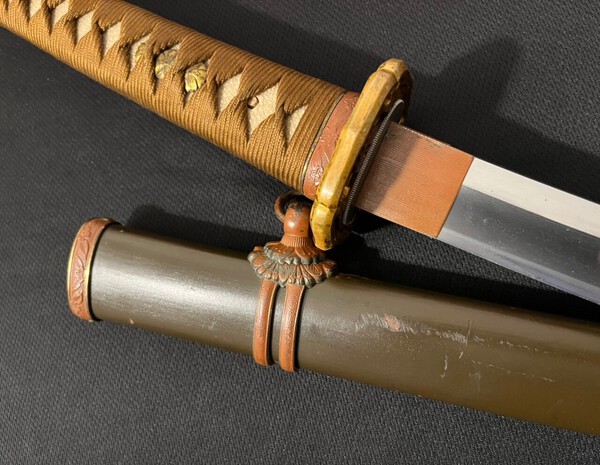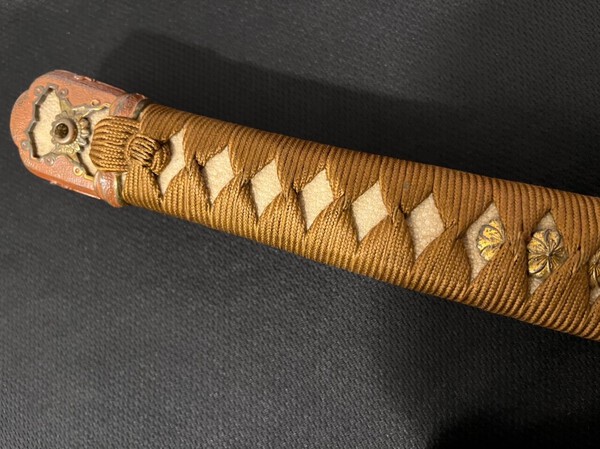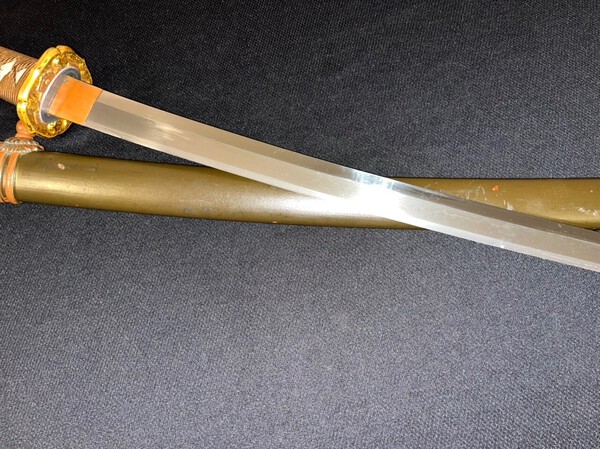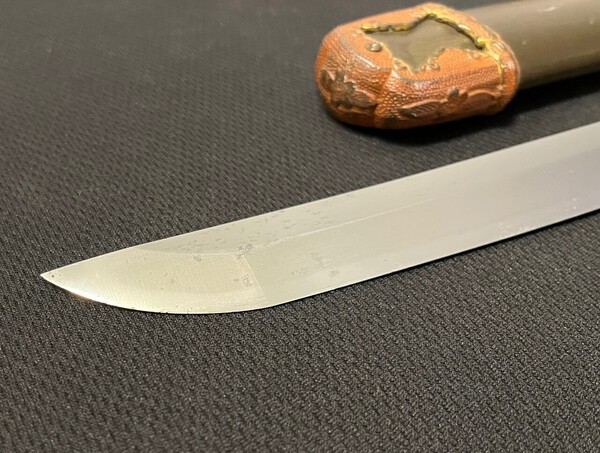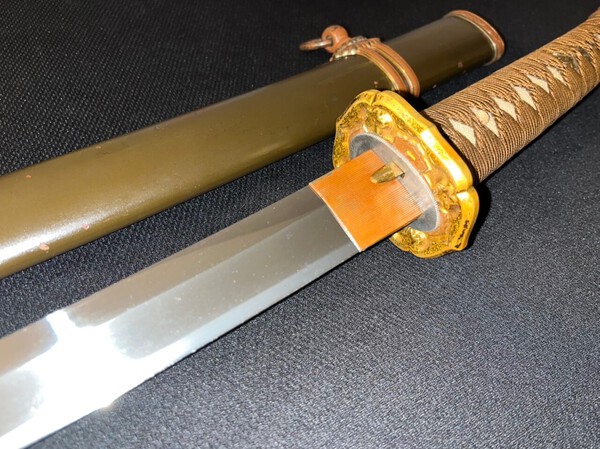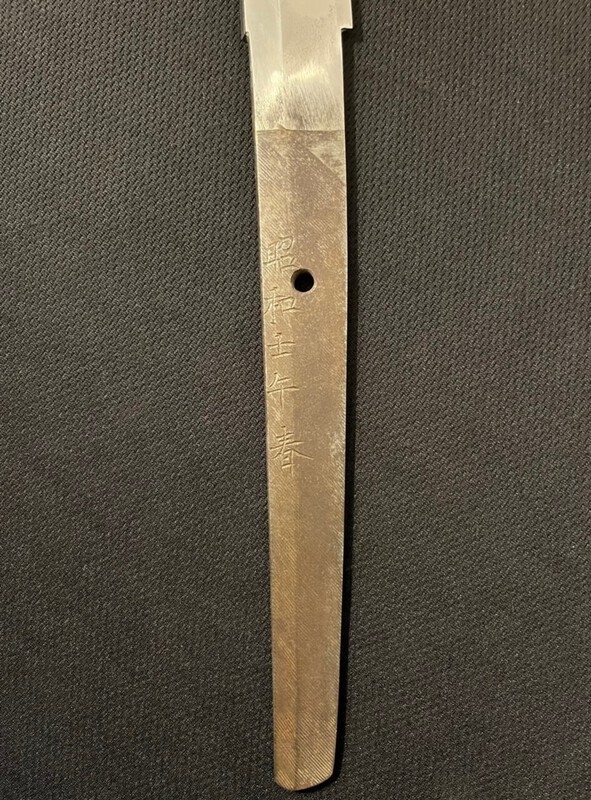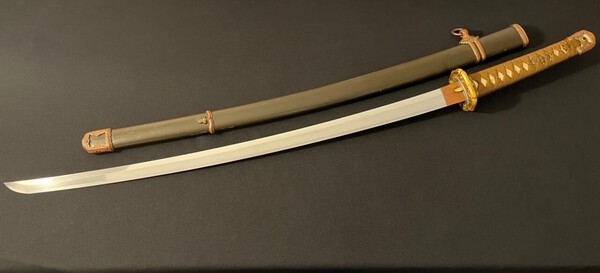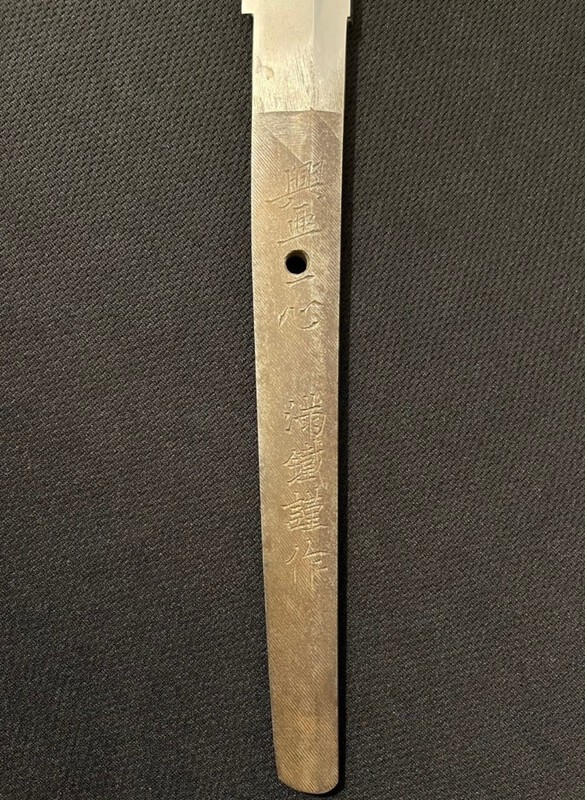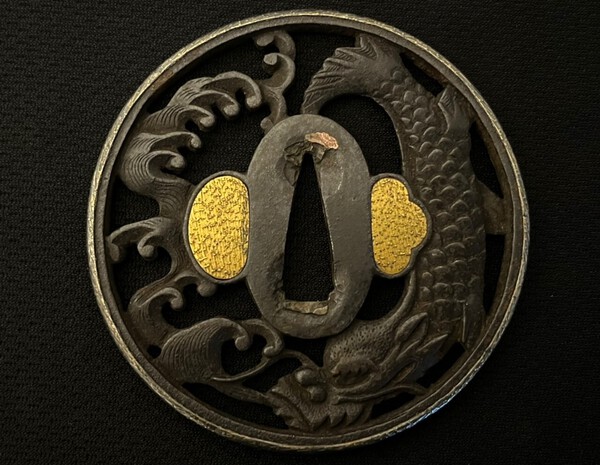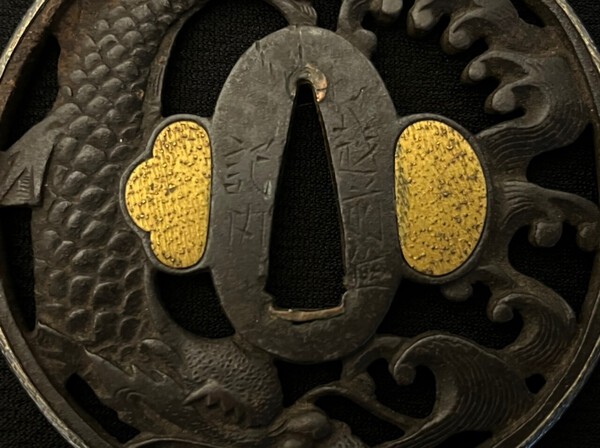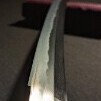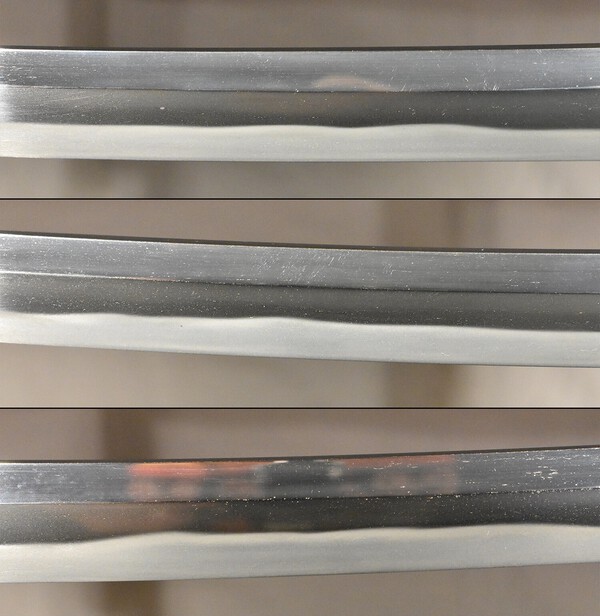Search the Community
Showing results for tags 'katana'.
-
Hi I have acquired a Shin Gunto blade and was wondering what the translation meant and if it is the swordmaker etc. There is a very small 46 stamped near the start of the blade as well. Any help would be greatly appreciated. Thanks Rod Sydney
-
If you missed out on the swords from the John Plimpton collection when they were for sale a while back, here's another chance to buy one. In fact, St. Croix Blades bought almost 50 of the Plimpton swords--we've just stowed them away to be listed here every so often. Japanese NCO sword photographed for John Plimpton's book Swords of the Emperor - A Guide to the Identification of Imperial Japanese Swords, 1873 – 1945. A book sword would make a rare addition to any collection. The sword and scabbard/saya have the matching serial number '79432'. A premium sword for only the finest collections. CONDITION: This sword is in mint condition. Here is the link for the full listing: https://stcroixblades.com/shop/products/Japanese-nco-sword-from-the-plimpton-collection-premium-condition-published/ $3000 (If paying via credit card or PayPal, 4% credit card fee/PayPal fee added to the purchase price). Free shipping within the U.S. Overseas customers--contact me for shipping cost--I will deduct the amount I would have paid for postage within the U.S. from your shipping total as credit)
-
Hello folks! I've got a katana a friend here needs a translation/ID for. I believe it to be mid-late 1800's but I could be very wrong. Its numbers: Nagasa: 29.25 inches Sori: 0.75 inch Nakago: 9 inches Height at yokote: 0.875 inch Hamon appears bright and attractive, the hada is indistinct. Appears to have osaka-yakidashi with nice kaeri on the boshi. I'll let the pictures do the rest of the talking:
-
If you missed out on the swords from the John Plimpton collection when they were for sale a while back, here's a chance to buy one. In fact, St. Croix Blades bought almost 50 of the Plimpton swords--we've just stowed them away to be listed here every so often. THE Japanese Police shingunto sword photographed for John Plimpton's book Swords of the Emperor - A Guide to the Identification of Imperial Japanese Swords, 1873 – 1945. This sword would make an important addition to any Premium collection as it is most likely the, or one of the, best condition examples of the Japanese Police Shin-gunto Sword known. Note the Police badge on the fuchi (handle fitting). The Japanese Police gunto is very hard to find. The cutting edge/nagasa measures 25 5/16". CONDITION: This Plimpton Collection sword is nearly mint. (For perspective, we have only owned two other Police shin-gunto swords--and have seen another one--these swords are almost always is rough condition from heavy carry wear). $2900 shipped (If paying via credit card or PayPal, 4% credit card fee/PayPal fee added to the purchase price). Here is the link to the other photos: https://stcroixblades.com/shop/products/Japanese-police-shin-gunto-sword-from-the-plimpton-collection-premium-condi/ --Matthew Brice www.StCroixBlades.com
-
This sword was discussed in detail on the nmb. Super interesting. Here is the thread: https://www.militaria.co.za/nmb/topic/40635-translation-help-on-additional-kanji-on-masanaga-gendaito/#comment-419437 1 WW2 Japanese Army Officer's sword made by Masanaga available. Masanaga's given name was Ito Kishinaga. While making swords at the Minatogawa Shrine, Masanaga signed his swords under the name Masakiyo. He also made Special Order swords at a nearby forge. When making swords at this forge, called the 七生刀鍛煉道場 'Seven Lives' Forge, he signed as Masanaga. See photo of the graphic provided by Trystan on the Nihonto Message Board on Ito Kishinaga/Masanaga/Masakiyo. The Minatogawa Shrine was dedicated to Kusunoku Masashige. Before he lost his life in battle in 1336, he uttered the phrase 七生報國 'Shichishō Hōkoku'. This means 'would that I had seven lives to give for my country'. As mentioned above, the forge near the Minatogawa where Special Order naval or army swords were made, was referenced as the 'Seven Lives' Forge. This sword is dated October 1943. The number '17' is stamped on the nakago's mune. This sword has two latch releases. See photo provided from Jim Dawson's book Swords of Imperial Japan 1868-1945 Cyclopedia Editiion. The blade measures 26 5/16" (67.6 cm) (measured properly from the blade tip to the notch in the blade spine). This traditionally-made gendai katana has an expertly water-tempered wavy hamon. This Japanese WW II Army Officer's katana is in 1944 shin-gunto mounts (aka Type 3 mounts). CONDITION: The handle wrap is perfect. The sword locks in the saya, and the lock release buttons function perfectly. The saya is perfect. There are some tiny specks of paint on one side--but the whole condition of this sword is such that it just blends in--the condition is so exceptional. There are two nicks in the blade edge. They are such that they only go 10-15% of the thickness of the hamon. The blade will polish beautifully if desired. But the blade is exceptional without a polish. The temper line and boshi are perfectly healthy. This sword is guaranteed against fatal flaws. $3600 (If paying via credit card or PayPal, 4% credit card fee/PayPal fee added to the purchase price). Here is the link to the complete complement of photos: https://stcroixblades.com/shop/products/masanaga-Japanese-ww2-samurai-army-sword-1944-mounts-minatogawa-shrine/ --Matthew Brice www.StCroixBlades.com
-
Exceedingly rare Japanese WW2 Iida mount Army Officer's gendai sword available. This sword is among the most rare of all Japanese military swords. These mounts are referred to as the Iida seal--or the Iida lock, named after its inventor Iida Kunitaro. This exceptional Japanese Army sword would make an important addition to any collection. This sword was made the 2 Million Yen smith, Imai Sadashige. Imai Sadashige earned the title of Sword Forging Teacher/Special Honor Noted Seat at the 1941 Sword Exhibition. Sadashige is featured on page 150 & 151 in John Slough's book, An Oshigata Book of Modern Japanese Swordsmiths 1868-1945. The blade measures a long 26 7/8" (68.3 cm) from blade tip to the notch in the blade spine. The Iida lock is a weather-proofing mount designed to keep water and dirt out of the saya. This exceptionally rare sword would make an important addition to any collection. Information on the Iida (IIDA) lock can be found on pages 168 & 169 of Jim Dawson's book, Swords of Imperial Japan 1868-1945 Cyclopedia Edition. Additional information can be found in Fuller and Gregory's book Japanese Military and Civil Swords and Dirks. The hamon is exceptional--the temper line billows almost all the way up to the shinogi line. Once polished this sword will be a screamer. Sadashige's work is exceptional. Look at the photos of the hamon to see clues of what will be revealed in the blade once polished. The saya is a special lightweight variation--made of lacquer-covered wood. CONDITION: The mounts on this antique Japanese World War II Army Officer's sword are in excellent condition. The blade saw only superficial oxidation--this sword will polish beautifully. I can arrange or provide a referral for polish if the buyer wishes. The Iida lock functions perfectly. Here is the link to the full listing with photos: https://www.ebay.com/itm/363974444219 Available for $400 less than list price if purchased direct via info@stcroixblades.com. --Matthew Brice www.StCroixBlades.com
-
I am selling my gunto. It's in great shape. The blade is immaculate and the saya is in amazing condition. I had the maker's etching under the tsuba identified and translated (and will include pics so you can identify yourself.) The button that operates the release to open the saya works perfectly. It was made by Yoshimichi in August 1943. My wife is really sick and is getting worse. I have a ton of bills that I have to attend to. Even though I love the katana andI've had it since I was 18 (I'm 45,) I really have to to be able to care for her. I'm trying to get $1700 US. I know people have told me It could go for as high as $2000 but I really need the money.
-
So, the story of this one os a bit of a doozy. Well, I bought this katana arround 3 years ago right before covid in southern Brazil, and only got the time to research it further a couple months ago. I bought it on a flea market believing the word of the seller that this was a old training sword...so that's a great start. Now I do believe what I bought is in fact one of the most misstreated type 98 in the world, but I'm here to hear a second informed opinion...is that really a 98? The scabbard was almost cpmpletly sanded down to bare metal, though you can still see the finishing in a few spots, the seppa and tsuba are all glued together with a verry stong glue(if any of you got any ideas of how to get them separated withoud damadging it further, do tell)...worst yet this glue dribbled all over the sword in every tiny crack and now its whitening from time...in short, a disaster. You can vaaaguely see what I believe is whats left of the company logo that sold/build the sword and a faint 4 on the seppa I believe, also inside the fuchi its inscribed "X IX", not in the photos because I reasembled it already, but if someone is interested I can take a picture tomorrow. either way, I'd like to know if someone can tell me if this is a real 98, and if it is how can I fix this poor thing up? should I fix it up?
-
Hello, everyone. I hope you're all doing well. I was wondering about the works of the smith Kiyomaro. I had a few questions about him. -Why was his work important to the nihonto community? -What are the characteristics of his work? -Where can I learn more about him? (Specifically, which books should I use to learn more about him?) Thank you all. I hope I'm not bothering anybody.
-
14 New swords, tassels, etc. just listed. …plus, it’s another ‘Make An Offer Weekend’ on the site! Contact us to make an offer. https://stcroixblades.com/shop/Japanese-swords/ —Matthew Brice www.StCroixBlades.com
-
Desirable Japanese WW2 Yasukuni Shrine sword by Yasuyoshi available. This Yasukunito would make an important acquisition for any collection. The blade measures 65 cm (25 5/8") from blade tip to notch in the blade spine. CONDITION: This sword is in wartime polish with not a single edge nick. Thw saya has dents from time in combat. The tsuka/handle is perfect. There are very occasional light surface finish changes on the blade from just the very beginnings of past oxidation. The blade is perfectly straight. The hamon and boshi are perfectly healthy. https://stcroixblades.com/shop/products/Japanese-yasukuni-shrine-sword-yasuyoshi-antique-ww2-samurai-wwii-army/ $6500 obo --Matthew Brice www.StCroixBlades.com (If paying via credit card or PayPal, 4% credit card fee/PayPal fee added to the purchase price). Overseas customers--contact me to get an accurate shipping quote for your address.
-
Hello. Could I get some help with this signature? I get Shigemichi...I think. But I can't read the rest. Thank you! --Matt
-
For Sale: $8750 (plus shipping and PayPal or credit card fee of 4.4%) 1 antique Japanese WW2 Yasukuni Shrine sword by Kagiyama Yasunori available. Yasunori was one of the founders of the Yasukuni Shrine Forge. This is a Special Order katana by Yasunori. This rare Special Order Yasukuni Shrine sword would make a fine acquisition for any collection. This sword is of special importance. The ura/inscription on the nakago reads ‘Commemorating the 2600th year of the founding of the Empire for the Aihara family and their succeeding generations’. This sword was made on a 'Lucky Day in January 1940'. This sword is of an unusual length for Yasukuni Shrine swords. This sword measures 27 9/16” from blade tip to the notch (mune) in the blade spine. A Yasukuni Shrine sword with these features is very rare among Yasukuni blades. The kabutogane has the mon of the Asano Samurai clan. The hamon is more complex than suguha—there are waved features within the hamon. The tsuba has the harp stamp associated with Yasukuni-to. The saya has been protected by the leather combat cover—the saya lacquer looks to be quite perfect under the cover. CONDITION: The blade is in original Japanese polish. There are no nicks. The hamon and boshi are perfectly healthy. The scabbard lock functions perfectly, and the silk sarute is still intact. This is an exceptional and rare Yasukuni Shrine sword.
-
Bishu Osafune Kiyomitsu, Katana in Koshirae Age: Blade: Muromachi period (AD. 1560) Tsuba: Edo period Mei: 備州長船清光作(Bishu Osafune Kiyomitsu Saku, made by Kiyomitsu of Osafune) 永禄三年八月日(3rd year of Eiroku, August. AD. 1560 August) Blade length: 66.3cm Blade is old polished, and overall in good condition with normal signs of scars and stain. This is an antique made in hundreds of years ago. There are imperfections or blemishes due to aging. Please see the pictures for details. Price: $4000 (include shipping cost within the U.S.) Reasonable offers accepted, please PM if interested.
-
So, I've just purchased my first 日本刀, forged by Tanba no Kami Terukado, an early-Edo period smith. As he's my entry point into Japanese swords, I'd like to find out more about him, the blades he produced and (eventually) learn to compare / appraise his work in contrast with other smiths / periods. This is purely amateur research for my own hobby use, I've got no commercial interests and won't be selling anything etc. Any help in corrections, further / primary sources and examples of his work would be greatly appreciated. Profile Considered as a "leading Mino smith" in "The Connoisseur's Book of Japanese Swords" by Kokan Nagayama. "He is listed as working in Mino 1658-1684. He was also considered one of the Zenjo smiths and listed as Seki-Kaji-Toryo ” master of all Seki smiths”. The Tegai influence is easily recognized within this work. " - source: https://nihontoantiques.com/project/wakazashi-sword-fss-697/ Signatures Zenjou no Fujiwara Kanekado 丹波大掾藤原照門 (Tanba no Daijou Fujiwara Terukado) 丹波守藤原照門 (Tanba no Kami Fujiwara Terukado) 1659 on? Together with a few other variations. Active years 1658-84? School Yoshisada (Mino) Ratings Hawley's: 60 points Toko Taikan: ¥2.8M Fujishiro: "Jo Saku" -source: https://nihontoclub.com/smiths/TER16 Notable owners Isami Kondo (a Tokugawa Samurai, a member of the "Shinsengumi", later executed after capture). - source: https://www.samuraimuseum.jp/shop/product/antique-Japanese-sword-katana-signed-by-terukado-nbthk-tokubetsu-hozon-certificate/
-
Dear NMB members, I am in need of your knowledge - in regard to pinpoint the sword smith (Mei translation) and if possible how that correspond with period and sword dimensions. I fully understand that this post may be a combination of more than one forum, but I will very much appreciate any comments that you may have. I have just acquired a katana with the following dimensions and information: Katana sword (Edo period 1600 - 1868) - supposedly 🤔 Full length: 105 cm Nagassa: 75,5 cm Sori: 2,5 cm Motohaba: 3,28 cm Motokasane: 0,68 cm Weight of blade: 880 grams Mei: Tadatsugu Nakago: one Mekugi Ana (drilled hole) Very nice and heavy sword with a beautiful Harmon that in shape and form correspond well with the middle Edo period (Jokyo and Genroku era between 1684 - 1703). And it is very sharp and in good polish. Question: Does the Mei correctly correspond with the signature of “Tadatsugu”? If so - which one, as I find it difficult to identify a smith with that name that made swords around 1684 - 1703? Pictures include sellers (1 + 2) and my own in regard to Mei and Kissaki (3 + 4 + 5 + 6). I will appreciate all of your comments, reflections and / or potential misgivings if you should have any. best regards Soren
-
Hello everyone, I bought this piece a few months ago. The blade length is around 66.3cm, some scratches can be observed, so I think maybe a polishing work should be done. This is an unpapered sword. I think it is stereotypic late Muromachi. The mei is Kiyomitsu and I assume it is legit. Would this be a correct assumption? Thanks everyone.
-
1 desirable Koa Isshin Mantetsu WW2 Japanese Army Officer's sword available. This Japanese Mantetsu sword would make an important addition to any collection. This sword has exceptional early mounts. Note the deep red color of the lined habaki. Note too the early War red color of the fittings. This sword is signed 'KOA ISSHIN MANTETSU SAKU'--meaning 'Develop Asia by One Mind Mantetsu respectfully made this'. The reverse side of the nakago is dated. The spine of the nakago is also marked. This fine sword measures 26 1/8" (66.3 cm) (measured properly from the blade tip to the notch in the blade spine). CONDITION: This World War II Japanese Mantetsu sword is in excellent condition. The hamon and boshi are perfectly healthy. The blade edge is excellent with no nicks. The blade has occasional staining from past oxidation that had just begun to form, and was removed. The blade is perfectly straight. The handle and fittings are in excellent condition. The sword locks tightly into the saya/scabbard, and functions perfectly. $3500 (If paying via credit card or PayPal, 4% credit card fee/PayPal fee added to the purchase price).
-
Hello! I could use some help with another translation—this time on a dragon/sea serpent themed fine iron tsuba. Thank you in advance to whomever can help! —Matt
-
I offer for sale a premium gendaito made by the famous gendai smith Takahashi Yoshimune. This katana comes in very fine samurai mounts. The total condition of blade and koshirae is near mint. The sword has a well grained and tight ko-itame hada and at times also a burl of ko-mokume hada. The hamon is a soshu style notare, made of dense ko-nie and a deep nioi guchi. In the monouchi the hamon is entirely ko-nie. The katana has a maru boshi. There are activities like nijuba, uchinoke and nie hoture in and around the hamon. The nakago has the mei: Sekishin Houkoku Minamoto Yoshimune Saku dated: Koki Nisen Roku Hyaku Ni Nen San Gatsu Hi ( a lucky day in March 1942 ) Yoshimune is ranked as a saijo saku smith and is rated as a high to superior grade gendaito smith, according to Slough‘s Modern Japanese Swordsmiths ( page 198 and 199 ). In addition Yoshimune is known for his patriotism and his swords sometimes have patriotic sayings. On this sword the saying ‚Sekishin Houkoku‘ can be translated as ‚serving the country with the utmost sincerity‘. The tsuka of the mentioned koshirae is silk-cord wrapped and contains custom menuki. The iron sukashi tsuba was probably made in the mid edo period. Besides there are two seppas made of copper. The blade measurements are: Nagasa: 66cm Sori: 1,5cm Motohaba: 3,0cm Sakihaba: 2,0cm Kissaki Nagasa: 3,0cm Nakago Nagasa: 20,8cm Kasane: 0,7cm My asking price is 4400€. I am open to reasonable offers, but I am not interested in trading. The sword is in Germany. I ship worldwide with DHL premium international. Payment should be done with paypal. The shipping costs are included. Kind regards Stefan
-
I'm looking to get a sword which can be used for tournaments (kata, tameshigiri, etc) and I'm unsure of which sources to go with. I've been considering getting an antique sword and having it fit with koshirae. Though I'm unsure. I'm curious if anyone knows any sword makers that make tournament quality swords. I've talked to makers from Japan, but their prices to commission a sword are far beyond what I can pay.

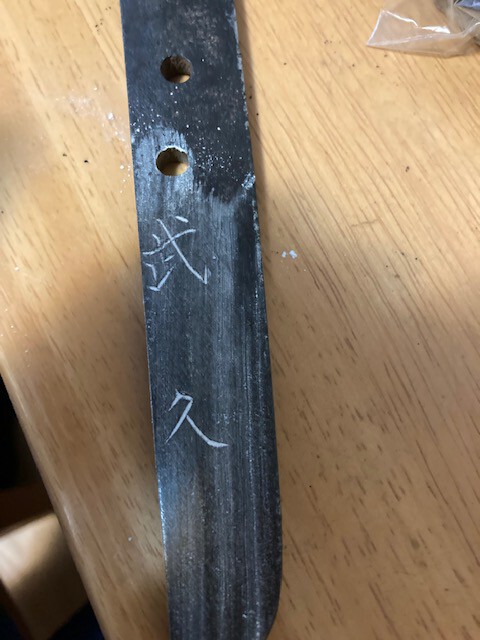


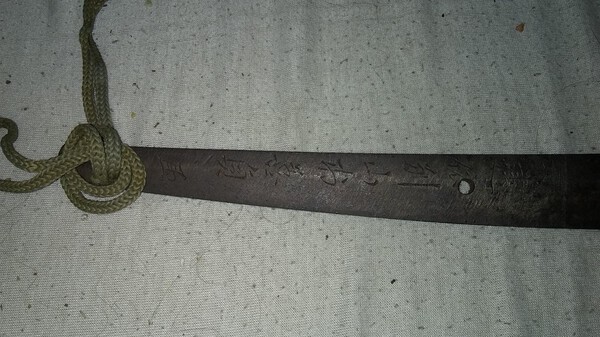
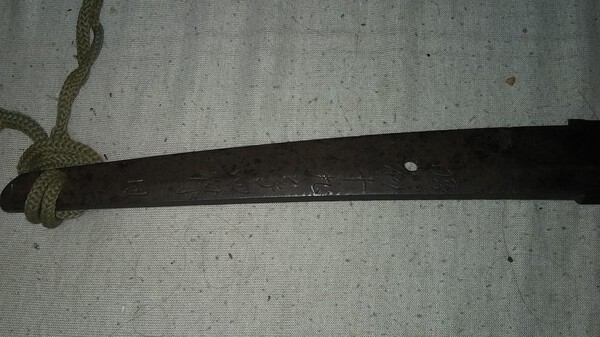














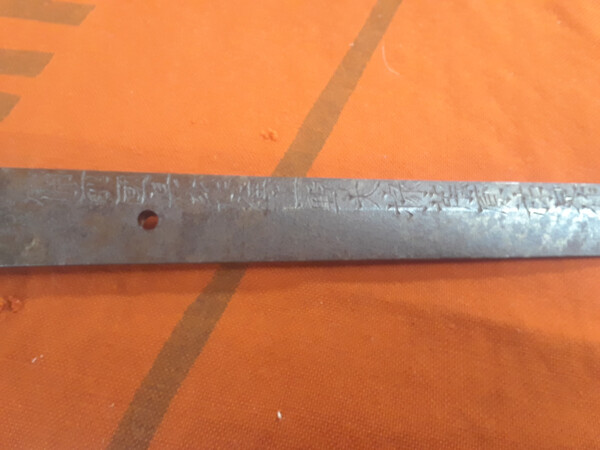



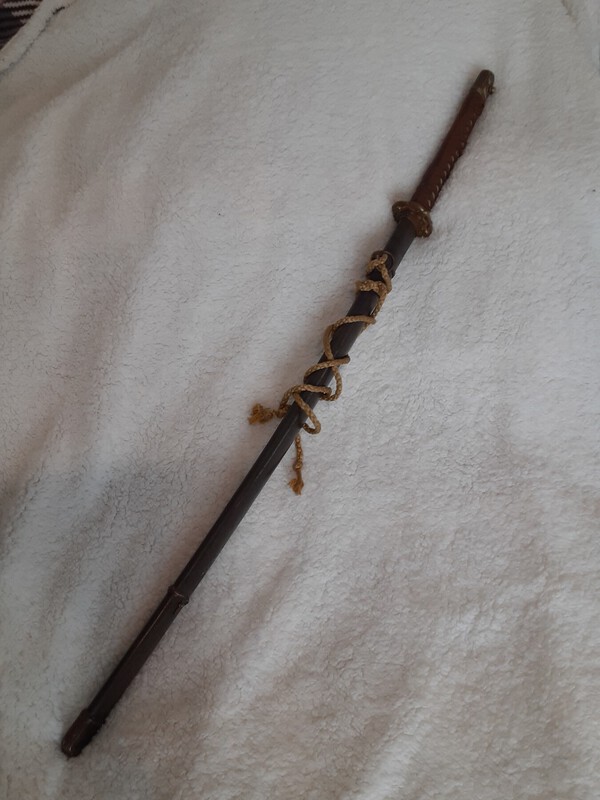

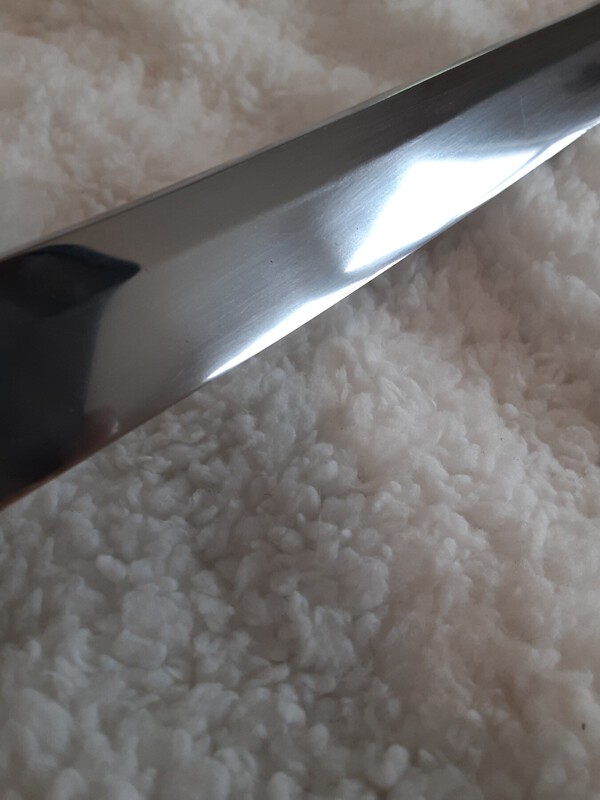







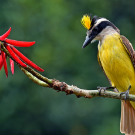
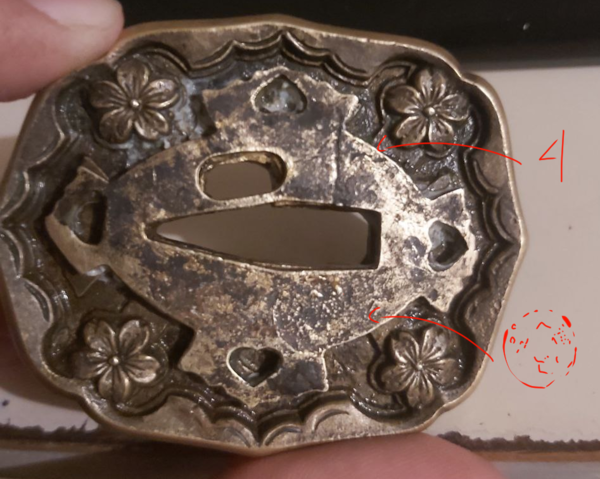
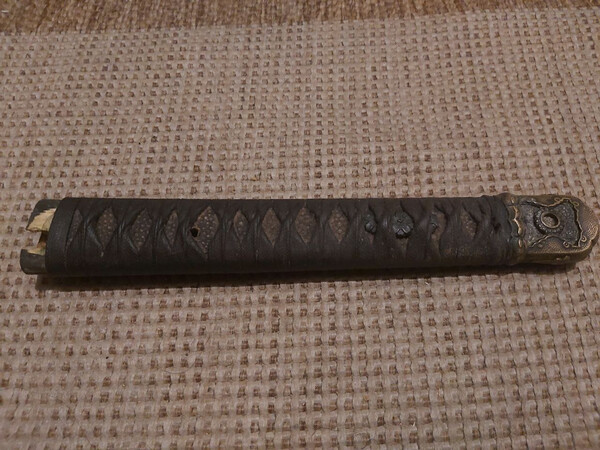
.thumb.jpg.bb6b715adfeef49cb0b9f0d8fb3dd39e.jpg)
